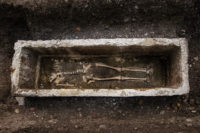 A burial ground centered around the grave of an elite Christian Roman woman has been discovered in Ljubljana, the capital of Slovenia. Modern-day Ljubljana began in 1st century B.C. as a castrum, a Roman fort, that developed an associated civilian settlement. Historians believe the city of Emona was built by imperial decree in 14 A.D. after the legion departed. Located on the Ljubljanica river, it was an important center of trade between the Adriatic and the Danube area and was the seat of a bishopric in the Early Christian era. It was destroyed by Attila the Hun in the 5th century. The city of Ljubljana grew on the site in the Early Middle Ages.
A burial ground centered around the grave of an elite Christian Roman woman has been discovered in Ljubljana, the capital of Slovenia. Modern-day Ljubljana began in 1st century B.C. as a castrum, a Roman fort, that developed an associated civilian settlement. Historians believe the city of Emona was built by imperial decree in 14 A.D. after the legion departed. Located on the Ljubljanica river, it was an important center of trade between the Adriatic and the Danube area and was the seat of a bishopric in the Early Christian era. It was destroyed by Attila the Hun in the 5th century. The city of Ljubljana grew on the site in the Early Middle Ages.
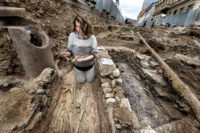 Archaeologists began excavating the site on Gosposvetska Street in August of 2017 in advance of construction. Roman graves had been found nearby before and experts expected they might find more. They did indeed, more in quantity and higher in quality than expected. The cemetery, about 2000 feet away from the northern walls of the Roman city, dates to the second half of the 4th century A.D. and contains more than 350 burials. Many of them are simple inhumation graves. Others include expensive sarcophagi that were made out of limestone quarried from
Archaeologists began excavating the site on Gosposvetska Street in August of 2017 in advance of construction. Roman graves had been found nearby before and experts expected they might find more. They did indeed, more in quantity and higher in quality than expected. The cemetery, about 2000 feet away from the northern walls of the Roman city, dates to the second half of the 4th century A.D. and contains more than 350 burials. Many of them are simple inhumation graves. Others include expensive sarcophagi that were made out of limestone quarried from 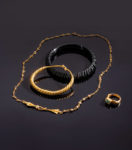 Moravče, 20 miles east of the city. The remains of a six-year-old girl were found interred in one of these pricey sarcophagi. She was buried with a lovely set of jewelry — one solid gold bracelet, one dark glass bracelet, a necklace of gold rings and glass beads and a gold finger ring with a green stone.
Moravče, 20 miles east of the city. The remains of a six-year-old girl were found interred in one of these pricey sarcophagi. She was buried with a lovely set of jewelry — one solid gold bracelet, one dark glass bracelet, a necklace of gold rings and glass beads and a gold finger ring with a green stone.
The stand-out is a burial chapel or mausoleum that contains the remains of one 30 to 40-year-old woman who must have been a very important member of the community.
The most stunning artifact recovered beneath Gosposvetska Street was a transparent blue glass bowl found next to the woman’s body. The 1,700-year old vessel is decorated on the outside with grapes, and vine leafs and tendrils. A Greek inscription on the inside of the bowl instructs the owner to “Drink to live forever, for many years!”
This exquisite drinking bowl could have been used in both regular daily life as well as for burial ceremonies, and an analysis of its chemical composition points to its manufacture somewhere in the eastern Mediterranean region. The grapevine decorations have their role in the Christian Eucharist and Communion, but have their origins in motifs associated with Dionysus, the pagan god of wine and ecstasy.
Archaeologists are also interested in how the woman’s tomb developed over time. It seems that possibly within a decade of her burial, her square chapel was demolished and a larger (30-by-40-foot) structure was built to enclose her tomb. Around the new structure and inside it, Emona’s Christian community began to practice a burial practice known as ad sanctos, in which the deceased are interred near the tombs of saints and other remains considered holy.
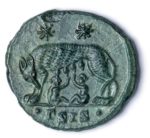 If she was the first or very early burial, her grave’s location at the center of a cemetery that grew up around her would identify the woman not just a person of high social status, but also someone of religious significance the Christian community that flourished in the city after the last of the persecutions under Diocletian in the early 4th century.
If she was the first or very early burial, her grave’s location at the center of a cemetery that grew up around her would identify the woman not just a person of high social status, but also someone of religious significance the Christian community that flourished in the city after the last of the persecutions under Diocletian in the early 4th century.
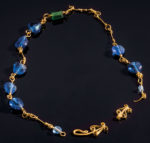 Her skeletal remains will be studied in the hope that some of the questions about her status in the community, the date of her death and her origins might be answered. A selection of the most exceptional artifacts discovered in the graves have gone on display in the treasury of the City Museum of Ljubljana.
Her skeletal remains will be studied in the hope that some of the questions about her status in the community, the date of her death and her origins might be answered. A selection of the most exceptional artifacts discovered in the graves have gone on display in the treasury of the City Museum of Ljubljana.
Roman findings are so routine that it hardly seems worth fussing about most of them. When did one last change historians’ understanding of anything important?
Now, if somebody found Carthaginian remains in Kent that would be worth fussing about.
Or in Maine, eh?
Similarly, the world surely is already saturated with books about the Nazis. Short of demonstrating that Hitler’s grandma was a black, a period of silence on the topic would be welcome.
*likes Roman cemetery finds*
*understands a Roman’s fascination with dead Romans*
😉
Quickest application of Godwin’s Law I’ve ever seen in a comment thread! 😆
🐱 🐯 Ad Bestias!!! 🐱 🐯
I am with Trevor !
One cant get enough of Roman finds. And I live where there are plenty.
Maybe in the spring when I start extending my house there will be something in the excavations!!
fascinating, I too cannot get enough of Roman ruins….and I learned about Godwin’s law as well, great start to the day thanks all
Beautiful glass objects.
From ANALYSIS OF HISTORIC GLASS BY ION-BEAM METHODS
Roman glassworks produced raw glass in huge
blocks weighting several tons, which were
splintered in chunks and distributed commercially
for reworking into objects. A glass chunk of this
type was discovered close to Roman municipium
Nauportus (today’s Vrhnika near Ljubljana) as
early as 1886; yet it was the recent chemical
analysis that confirmed its manufacture with natron, and therefore its Roman origin (Istenič & Šmit 2012).
Roman glass was commonly recycled that may
partly obscure its primary origin.
These Latins did Rome around much, so it should be expected much evidence of their Romans is to be found. This comment is not intended to provoke a Pun-ic War.
dearime when I read your comments, I picture an old British fart. If you really believe what you wrote, you probably should Brexit this blog.